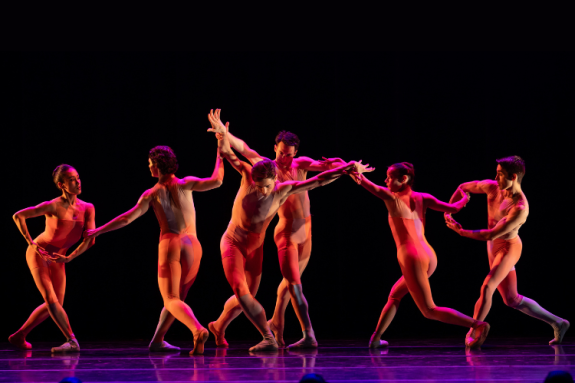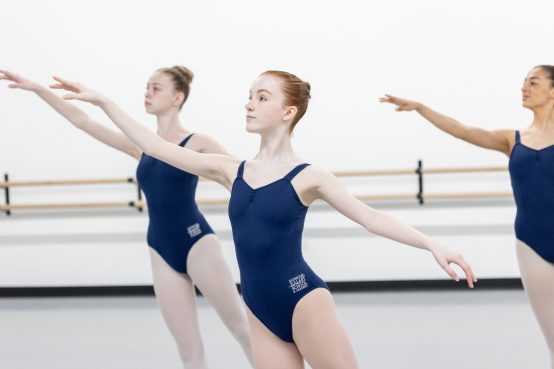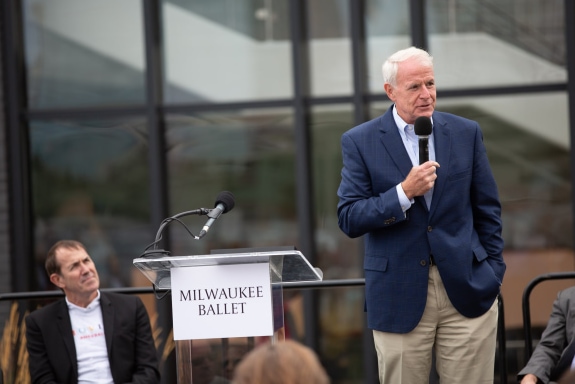About Milwaukee Ballet
Milwaukee Ballet's mission is to transform lives and connect communities through inspiring performance, community engagement, education, and training. Our vision is to be a national model of excellence creating innovative connections to ballet for artists, students, and audiences.
We are a Company of international artists, supported by a talented team of professionals and artisans. Our School & Academy attracts students from around the country to train under celebrated dancers, choreographers, and faculty. Our commitment to our craft is equal to our commitment to the community we serve.
Our Company
Milwaukee Ballet has earned its place among revered arts institutions; through Company performances alone we attract over 40,000 patrons to the theater, helping to solidify Milwaukee as a top destination and cultural hub in the United States. Under the artistic direction of Michael Pink, we present ballet stories that have endured for centuries as well as contemporary works that push the boundaries of dance
In addition to our international Company of Artists, we also elevate the next generation of dancers through our Second Company, Milwaukee Ballet II (MBII).
School & Academy
Milwaukee Ballet is home to the nationally acclaimed Milwaukee Ballet School & Academy (MBSA). MBSA is the only professional studio in the Midwest to be accredited by the National Association of Schools of Dance (NASD), which recognizes that our programs meet a rigorous set of national standards for excellence in dance training and organized operation. Across our three branch locations in the greater Milwaukee area, we attract over 1,000 students annually, ranging from age 3 to 22 from around the nation and world. We also offer numerous scholarships and financial aid opportunities each year to ensure that youth who express need are able to continue their studies with us.
Community & Outreach
Milwaukee Ballet strives to be an agent for positive social change in the community. Through our Community Engagement programs, we embrace a "ballet without boundaries" philosophy—increasing access to ballet and dance education, building a more accessible environment, and ensuring equity in the art form. We prioritize neighborhoods that experience residential segregation and income disparity that limit access to arts and culture activities. In a typical season, our Community Engagement programs serve more than 17,000 students, audience members, and other participants through hundreds of activities.
Our Supporters
The generosity of our supporters helps us achieve our mission to transform lives and connect communities through inspiring performances, community engagement, education, and training. We are grateful for the many donors, sponsors, and volunteers who choose to support Milwaukee Ballet each season. Every supporter is an integral part of Milwaukee Ballet’s ability to inspire and uplift.
Our History
We were founded in 1970 and are proud of the role we play in the Milwaukee community and culture.
1970's
Milwaukee Ballet was founded by Roberta Boorse, who dreamed of a professional ballet company in Wisconsin’s largest city. Boorse was passionate and relentless in her pursuit, famously camping out at New York City’s American Ballet Theatre to request guest appearances with her new Company.
Boorse also worked locally to get the organization up on its feet. Following an enthusiastic conversation with Adolph Suppan, Dean of the University of Wisconsin-Milwaukee’s School of Fine Arts, she recruited UWM’s Jury Gotschalks as the Company’s first artistic director, and Myron Nadel as its first resident choreographer. She engaged Lupe Serrano, an American Ballet Theatre dancer residing in the area, to teach weekly classes.
The curtain rose on rose on Milwaukee Ballet’s inaugural performance on April 24, 1970, at UWM’s School of Fine Arts. The audience was enraptured by excerpts from Polovetzian Dance, The Hill, and a pas de deux from Le Corsaire. Audiences were enchanted by stunning performances from guest stars Lupe Serrano and American Ballet Theatre principal dancer Ted Kivitt.
As Milwaukee Ballet grew in popularity, it began to present works never before seen by Milwaukee audiences. Within its first year, the Company sold out Coppélia, its first three-act ballet starring Cynthia Gregory and Ted Kivitt of the American Ballet Theatre.
Throughout the 1970s, Milwaukee Ballet continued to thrive. In addition to experiencing the arrival of artistic director Jean-Paul Comelin, in 1974 Milwaukee Ballet opened Milwaukee Ballet School, the official school of Milwaukee Ballet. In 1977, Milwaukee Ballet began performing The Nutcracker, one of America’s most popular ballets, for the first time. It was also during this decade that Milwaukee Ballet began to showcase its talents to audiences across the country.
1980's
At the end of a seemingly successful decade, fire struck the home of Milwaukee Ballet. Though the building was almost completely destroyed by fire, the Carley Development Corporation restored the building to appear as it did in the 1800s as Tivoli Palm Garden, a popular beer garden operated by Schlitz. This historic building on the corner of 5th Street and National Avenue became the Jodi Peck Center, which was Milwaukee Ballet’s home for 30 years.
American Ballet Theatre’s Ted Kivitt, who was a guest star in Milwaukee Ballet’s first full-length ballet, returned as artistic director, a position he held from 1980-1987, with assistance from his Ballet Master, Basil Thompson from 1986-1987.
As Milwaukee Ballet entered a new decade, it began to explore opportunities for long-term growth. After a successful decade of introducing more than 40 ballets, Milwaukee Ballet signed an historic agreement with the Pennsylvania Ballet creating a single joint-venture company of dancers, artistic direction, production staff, and repertoire. The Pennsylvania Milwaukee Ballet, which required dancers to travel between Philadelphia and Milwaukee, became the only classical ballet company in the United States to offer 52 weeks of work to its dancers. Though an artistic success, the Pennsylvania Milwaukee Ballet dissolved at the end of the 1988/89 season.
1990's
Although its financial woes were not yet past, the 1990s gave Milwaukee Ballet hope for a bright future, now led by Dane LaFontsee. A former Principal Dancer of Pennsylvania Ballet and Founding Director of Nashville Ballet, LaFontsee served as Artistic Director from 1990 to 1995. In addition to staging classical ballets and a few smaller, diverse collections, he supported Milwaukee Ballet School's "Identify Youth for Dance" program, providing scholarships for Milwaukee Public School students. He also hosted a weekly radio program "Dialogues on Dance," often joined by Daniel Forlano, revered Milwaukee Ballet Music Director for 20 years.
Former Ballet Master Basil Thompson was brought on as Artistic Director from 1995 to 2000 with a vision of building a Company that was equally skilled dancing contemporary works as it was full-length classics. Two notable performances staged under his direction included the world premieres of Ed Burgess’ The Firebird and Lisa de Ribere’s The Nutcracker.
Milwaukee Ballet School continued to thrive, serving nearly 1,000 students at three area locations. It remained ranked among the top ballet schools in the nation and provided instruction for
students ages 4 through adult. Milwaukee Ballet II also prospered, producing many artists who went on to celebrated careers at companies around the world.
2000's
From 2000 to 2002, Milwaukee Ballet's Artistic Director was Simon Dow, a former dancer with major companies including the Australian, Stuttgart, Washington, San Francisco, and Boston Ballets. In 2002, he organized the first Genesis International Choreographic Competition, which became a biennial tradition under Michael Pink's helm.
In 2002, Artistic Director Michael Pink brought a fresh new perspective to the company. His theatrical ballet style enlivened classic stories and made ballet relevant for a new generation of patrons. Pink soon became a Milwaukee icon, winning several choreographic, educational, and service awards.
By its 35th season in 2005, Milwaukee Ballet was ranked one of the top 12 ballet companies in the nation. Annually, the company was averaging 45 performances seen by more than 70,000 patrons.
In 2008, the School was renamed Milwaukee Ballet School & Academy (MBSA) and became an accredited institutional member of the National Association of Schools of Dance (NASD). By that time, the School had also been running its internationally attended Summer Intensive Program for over 20 years, giving students six weeks of daily ballet training culminating in a full performance.
A Community Engagement Department was created in 2005 under Pink's direction, establishing a dedication to outreach and community connections that would become central to Milwaukee Ballet's mission.
2010's
Under the continued direction of Artistic Director Michael Pink, Milwaukee Ballet flourished in the 2010s. The decade was shaped by the company’s mission of transforming lives and connecting communities through inspiring performance, community engagement, education, and training.
On the performance side, the Company found a strong groove, staging three to four full-length productions and one to two contemporary triple-bills per season. Pink enjoyed a prolific decade of choreography in the 2010s, debuting five new full-length works on Milwaukee Ballet in the span of eight years.
Milwaukee Ballet School & Academy built on the momentum of its accreditation with three area branches in downtown Milwaukee, Brookfield, and Fox Point. Each season, more than 100 studentsperformed alongside the Company in mainstage productions like The Nutcracker, Beauty and the Beast, and Cinderella. In 2019, the Rolando Yanes Pre-Professional Program was developed for advanced students in pursuit of professional careers.
Community Engagement efforts continued, adding new offerings with programs like Ballet Beat, a summer series of free activities and performances, and Tour de Force, an adaptive ballet program. The Company also staged its first-ever sensory-friendly performance of The Nutcracker, which provides an experience tailored to the needs of those with auditory or visual processing challenges.
With the company’s continued growth and in anticipation of its 50th anniversary season in 2019-20, it was decided that a new studio space was in order. A capital campaign raised $26 million to build Baumgartner Center for Dance, which opened its doors in September 2019.
2020-Present
Milwaukee Ballet ushered in its 50th anniversary season in 2020. At this milestone, the Company's roster included 24 Company Artists and 20 Milwaukee Ballet II Second Company dancers, 700+ Milwaukee Ballet School & Academy students, and thousands of community members served.
Sadly, this celebratory season—the first in the brand-new Baumgartner Center for Dance—was cut short due to the COVID-19 pandemic. Despite this immense challenge, the Company worked tirelessly to continue bringing dance to audiences, efforts of which included successful virtual touchpoints and condensed performances for smaller audiences such as The Nutcracker: Short and Sweet.
Thanks to the generosity of donors and the hard work of staff, the Company was able to return for its first full-length in-person season since COVID struck for 2023/24. This season marked Michael Pink's 20th anniversary as Artistic Director and therefore included many of his most popular works, such as Peter Pan, the first full-length work he premiered on Milwaukee Ballet back in 2010. The triumphant highlight was the premiere of The Nutcracker: Drosselmeyer's Imaginarium, Pink's reimagining of the holiday classic that included all-new costumes and sets. A $5 million Capital Campaign funded this production, which was hailed as " one of the grandest Nutcrackers of all" by Chicago Tribune.
The Company, School, and Community Engagement department continue to thrive up through the present. With excitement, ambition, and gratitude, all look forward to the ballet yet to come!
Stay Connected!
Make sure you receive all of the most up-to-date information from us by staying connected! Milwaukee Ballet e-newsletters are sent out bimonthly and contain lots of great content including performance updates, news from the company, special features, and more.
Haven’t been receiving our emails? Double check your spam/junk folders, move us to your inbox and select us as a Safe Sender.




